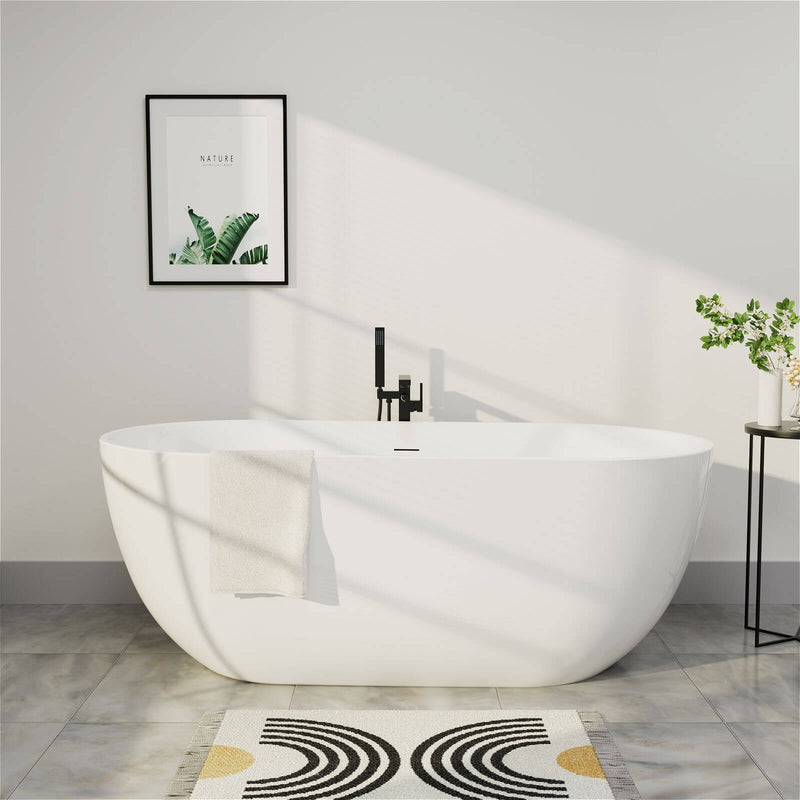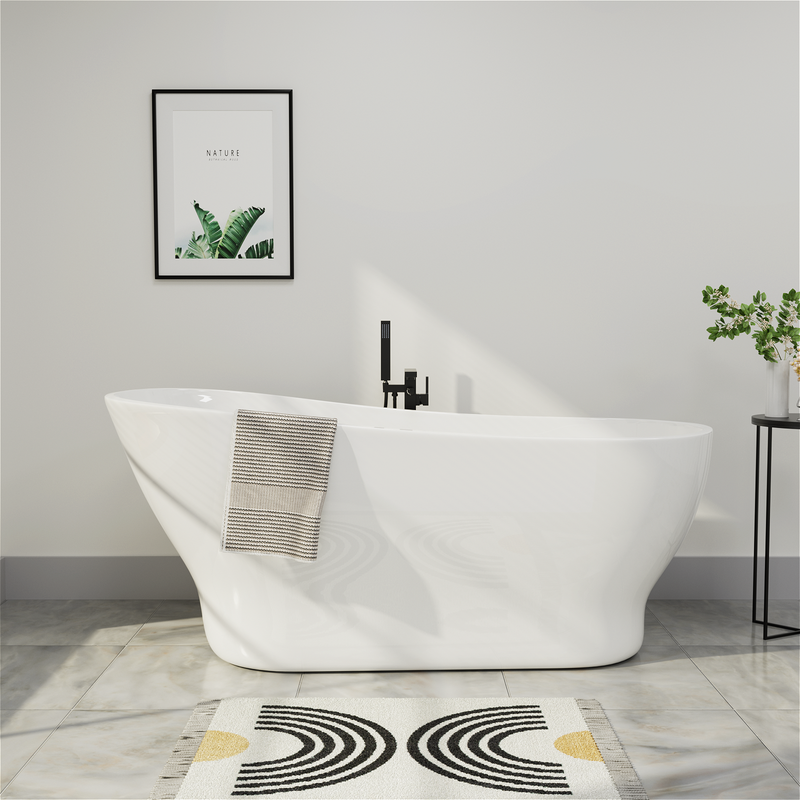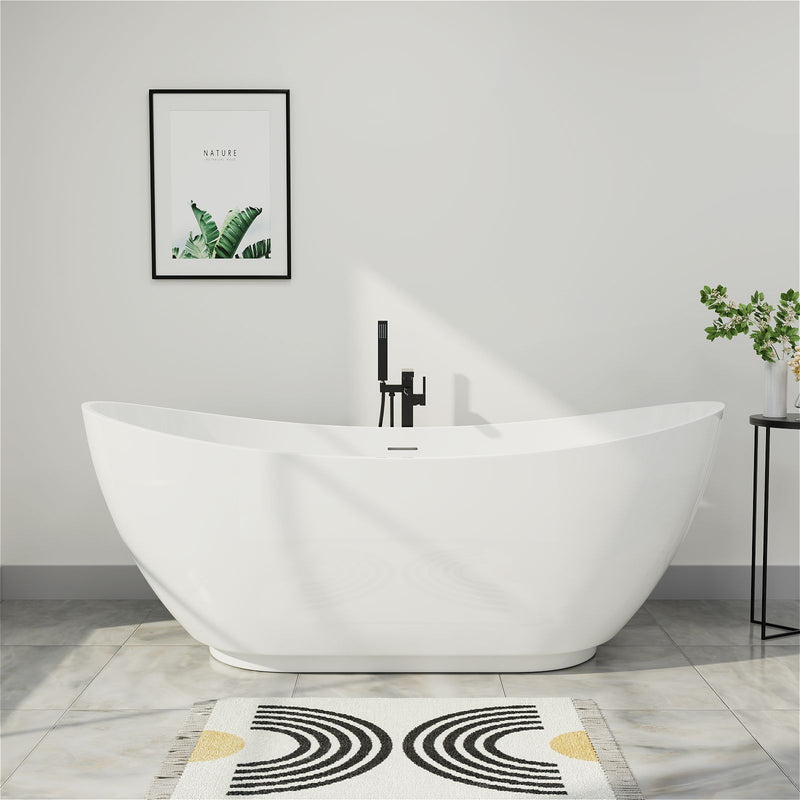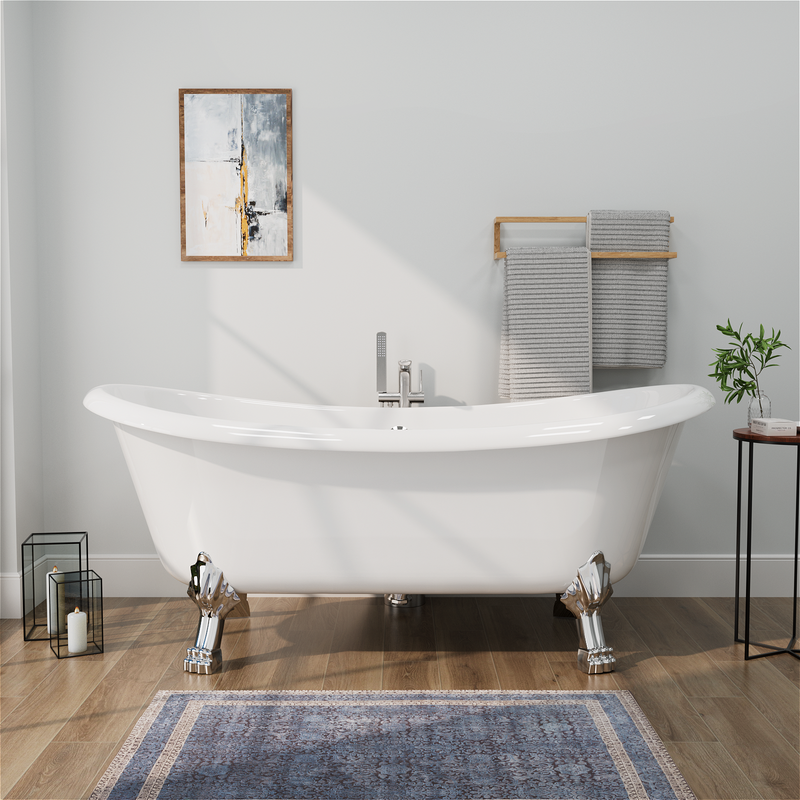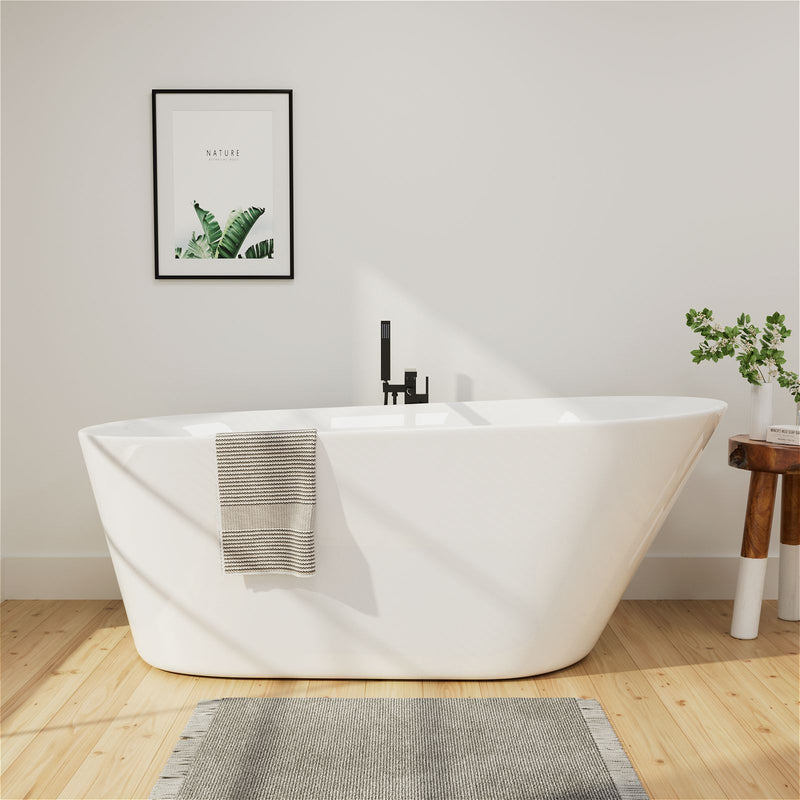Double slipper tubs — freestanding tubs with raised, sloped ends on both sides — are reappearing in modern bathroom plans as both functional fixtures and design anchors. In 2025 the shape keeps its classic comfort while adapting to practical needs: smaller footprints, new materials, tactile finishes, and integrations with wellness features. This article explains the key trends affecting double slipper tubs this year, including the design language, material choices, spatial strategies, installation considerations, and care tips.
Why Double Slipper Tubs are Relevant in 2025
Double slipper tubs answer several competing homeowner priorities at once. They offer ergonomic reclining on either end, which supports two-person bathing or gives one person flexible positions. At the same time they act as visual centerpieces in open-plan master bathrooms and retrofit projects that prioritize spa-like comfort and low-maintenance finishes. Professional design research for 2025 emphasizes wellness, personalization and freestanding tubs as focal points in primary bathrooms — all reasons double slipper tubs have strong traction among designers and homeowners this year.

Shape and Scale: Adapting Slipper Form to Modern Floor Plans
Compact Proportions and Deeper Soaking
Historically, slipper tubs often favored a long, elegant footprint. In 2025 there's a clear move toward more compact double slipper designs that increase interior depth while reducing external length. That trade — more depth, less length — lets homeowners enjoy full-body immersion without requiring oversized master bathrooms. Deeper interiors (18–22+ inches of water depth) create the soaking sensation people want while keeping the tub manageable for smaller layouts and easier delivery. This shift is visible across recent product roundups and design trend reports.
Balanced Symmetry, Central Drains, and Layout Flexibility
A defining design detail for double slipper tubs is symmetry. Many 2025 models place the drain near the middle or use central plumbing options so the tub can sit free in the room or be positioned against a transfer panel with equal comfort from either side. Central drain choices simplify plumbing in freestanding installations and allow the tub to be rotated or repositioned in future remodels — a practical advantage for homeowners who may repurpose a room later. Multi-positional plumbing is now a common option on newer models and helps the tub adapt to changing layouts.
Materials & Finishes: The 2025 Palette
Matte and Tactile Finishes
Glossy white tubs are still common, but 2025 design coverage highlights tactile, matte finishes and soft textures that read as understated luxury. Matte surfaces conceal water spots and finger marks better than high-gloss finishes, and they pair well with natural materials and warm metal fixtures favored in current palettes. Designers cite tactile finishes as part of the broader move toward natural, calming baths that read as spa-like and low maintenance.

Composite Stone Resin and Hybrid Cores
Stone resin and solid-surface composites have become more mainstream for double slipper tubs. These materials offer a warm, dense feel and excellent heat retention compared with thin acrylic shells. They are heavier — often requiring structural consideration — but they deliver the premium tactile quality many buyers want. Meanwhile, reinforced acrylic with improved backing and thicker wall gauges remains the cost-effective, lighter option for many homeowners, offering a balance of form, performance and price.
Colored Basins and Darker Tones
Statement colors and darker finishes continued to emerge in 2025. Rather than only white, tubs in deep charcoal, muted green, and off-white warm tones are used to create contrast with tile and wood. Designers often recommend keeping other finishes minimal when the tub color is strong, so it reads as an elegant focal point instead of visual clutter. Several trend roundups for 2025 highlight bolder bathtub finishes as a growing preference among homeowners.
Integration with Wellness and Technology
Soaking and Sensory Accessory Pairing
The wellness emphasis pushes bathtub design toward integrated rituals: chromotherapy lighting, subtle edge heating, and companion aroma or sound systems near the tub zone. For double slipper tubs, this often means thinking about placement — near windows for daylight, adjacent to built-in niches for aromatherapy diffusers, or with low-profile lighting that supports a calming soak. These features are less about building technology into the tub itself and more about designing the tub's environment to support relaxation.
Practical Tech: Overflow Sensors and Concealed Plumbing
On the practical side, modern installations increasingly use overflow sensors, thermostatic mixing valves, and concealed plumbing with easy access panels. These elements improve safety and serviceability without changing the tub's look. For households that will age in place or have children, thermostatic controls and anti-scald valves are particularly valuable additions that integrate seamlessly with current double slipper tub installations.
Placement Strategies and Bathroom Choreography
Freestanding Center Placement vs. Side Placement
A double slipper tub makes a very different statement depending on how it is placed. Center placement — with the tub as the room's sculptural element — is common in large master bathrooms and allows viewing from multiple angles. Side placement, against a half wall or near a window, preserves the freestanding look while saving circulation space. In 2025 designers often choose placement based on two priorities: sightlines (what you see when you enter the room) and service access (how easily a plumber can reach the trap and connections).
Wet-Room and Combined Shower Layouts
The wet-room approach, which merges bathing and showering into a single waterproofed space, grows in popularity. Double slipper tubs can function within wet rooms provided the slope, tile, and drainage are specified correctly. This layout reduces barriers and creates a spa-like, easy-to-clean surface environment — a priority highlighted by trend studies calling for lower-maintenance spaces. If you opt for a wet-room layout, carefully plan the water containment and slope to avoid splash issues.
Accessibility, Safety and Universal Design
Designers in 2025 balance aesthetics with safety. For double slipper tubs, simple adaptations can make a big difference: integrated grip edges, strategically placed non-slip surfaces, and easily reachable controls. Handrails can be designed to read as part of the composition rather than afterthoughts. Where households include older adults or those with mobility challenges, consider a lower stepped access or a blended solution — a double slipper tub plus a nearby walk-in shower — to satisfy both wellness and accessibility needs.
Materials, Maintenance and Longevity
Surface Care for Matte and Composite Finishes
Matte and textured finishes feel luxurious but require slightly different care. Gentle, pH-neutral cleansers and soft cloths are recommended. Avoid abrasive pads and strong solvents that can etch the surface. Stone-resin shells generally accept low-abrasion cleansers and maintain finish longer, but any porous grout or adjoining tile must be kept sealed to avoid staining that can affect the tub's visible edges. Manufacturer care instructions are the first reference for long-term preservation.

Structural Support and Professional Installation
Solid-surface or stone composite double slipper tubs are heavier and require consultation about floor loading, especially on second floors. Many 2025 renovation projects include a quick structural assessment early in planning to prevent last-minute reinforcement costs. In contrast, high-quality acrylic with reinforced backing is lighter and easier to retrofit into existing rooms with minimal structural work. Regardless of material, professional installation ensures level placement, watertight seals, and accessible service panels.
Color Palettes, Tiles, and Complementary Materials
Earth Tones, Green, and Muted Blues
Color trends for bathrooms in 2025 favor calmer palettes: warm neutrals, greens, and muted blues that create a restful backdrop for a sculptural tub. A colored double slipper tub in a deep, soft tone pairs well with natural wood vanities and stone or large-format tiles — a combination that designers repeatedly recommend for spa-like primary baths.
Tile Scale and Continuity
Large-format tiles and tile continuity between floor and bath surround are popular because they reduce visual clutter and make cleaning easier. Designers often recommend using the same tile plane from floor to bath deck or up a half wall to create a calm, unified composition that highlights the tub's curves rather than competing with them. This approach also reduces grout lines and long-term maintenance.
Sustainability and Responsible Sourcing
Sustainability is prominent in 2025 bathroom trends. Manufacturers increasingly document recycled content, low-VOC production methods and recyclable packaging. For double slipper tubs, this shows up in material transparency and sourcing statements: solid-surface composites with recycled minerals, low-emission acrylic formulations, and manufacturing claims that minimize waste. If sustainability matters to you, ask suppliers for environmental product declarations (EPDs) or material transparency statements before purchase. Industry research points to sustainability and wellness as twin drivers for many 2025 projects.
Cost Considerations and Resale Value
Budget Buckets
Double slipper tubs span a broad price range depending on material, finish, and installation complexity. A basic acrylic double slipper tub with reinforced backing is typically the most budget-friendly option. Stone resin or solid-surface versions raise the price due to material cost and increased installation labor (especially for structural work). Factor in plumbing rework, tile or floor adjustments, and possible joist reinforcement when estimating project costs.
Value for Resale
High-quality freestanding tubs, including double slipper styles, can add perceived value to a master bath if they match the home's overall finish level and are properly installed. Buyers respond positively to spa-like primary bathrooms, which can translate into better marketability for higher-tier homes. However, a mismatched or oversized tub in a small bathroom can reduce usable space and hurt practical appeal, so fit-to-space matters.
How to Choose the Right Double Slipper Tub for Your Home (Step-by-step)

- Define your priorities. Decide whether you want a centerpiece tub, a deep soaking experience, two-person comfort, or a practical balance. That choice narrows the material and size categories.
- Measure carefully. Record doorways, stair turns, and plumbing locations. Think about how the tub will be delivered and set in place.
- Select material with maintenance in mind. If you prefer low maintenance and lighter weight, acrylic with reinforced backing is usually best. If you want tactile luxury and superior heat retention, consider composite stone resin but budget for structural work.
- Decide placement and sightlines. A tub facing entry or a window makes a design statement; side placement saves circulation space. Confirm service access for plumbing.
- Plan safety and controls. Add thermostatic valves, anti-scald protection, and discreet grab surfaces if needed.
- Get professional input. Talk to a contractor or designer before ordering to confirm drain placement, reinforcement needs, and finish coordination.
- Ask about warranty and parts. Confirm what's covered and how the manufacturer supports replacement parts or refinishing if needed.
Frequently Asked Questions
Q: Are double slipper tubs practical for small bathrooms?
A: Yes — modern double slipper tubs are available in compact footprints, often trading length for increased interior depth. If floor space is tight, choose a shorter exterior length and confirm door/route access for delivery. Place the tub carefully so it doesn't block circulation or required clearances.
Q: Are double slipper tubs practical for everyday use, or are they primarily decorative?
A: Modern double slipper tubs are designed for regular use, with ergonomic features that enhance daily bathing experiences. While they certainly serve as striking focal points, contemporary designs prioritize practical considerations like comfortable reclining angles, secure entry and exit, and easy maintenance. Many users find the seated, semi-reclined position of double slipper tubs more comfortable and safer than fully reclining in deeper soaking tubs, making them excellent choices for both occasional luxury and daily use.
Q: How does the bathing experience in a double slipper tub differ from a standard soaking tub?
A: The double slipper tub offers a uniquely supported bathing position that many find more comfortable than standard tubs. The raised ends cradle the upper body, allowing for comfortable semi-reclining without the need for additional bath pillows or accessories. This position keeps the head comfortably above water while allowing full shoulder submersion, creating a sense of security and relaxation that many bathers prefer to fully horizontal reclining. The symmetrical design also provides flexibility—you can easily change your orientation to accommodate different views or to share the tub with a partner.
Q: What material gives the best heat retention?
A: Stone resin and solid-surface composites generally retain heat better than thin acrylic. However, a thicker-gauge acrylic with solid backing also performs well and is lighter and easier to install. Prioritize wall thickness and backing quality if heat retention matters.
Q: Do double slipper tubs require floor reinforcement?
A: It depends on material and filled weight. Heavy stone or solid-surface tubs almost always require a structural review and may need joist reinforcement, while most acrylic models will not, though you should still calculate filled weight and consult a professional for upstairs installations.
Q: How do I clean matte finishes without damaging them?
A: Use pH-neutral cleaners and soft cloths. Avoid abrasive pads or harsh solvents. For spot cleaning, diluted vinegar or mild soap works; always rinse thoroughly. Follow the manufacturer's care guide for the specific finish.
Q: Can a double slipper tub be used as a two-person tub?
A: Many double slipper tubs are sized and contoured for two people, but comfort depends on internal width, length, and depth. Review internal dimensions and, if possible, test a model in person for comfort. Consider drain placement and water volume when planning for two-person use.
Q: What colors are on trend in 2025?
A: 2025 trends favor warm neutrals, muted blues and greens, and darker statement colors like charcoal. These palettes pair well with natural materials and matte finishes to create calm, spa-like bathrooms.
Q: Will a freestanding double slipper tub fit in a wet room?
A: Yes, with proper waterproofing, slope design, and drainage. Wet-room placement changes how you plan for splash containment and floor drainage, so involve a contractor experienced with wet-room construction.
Conclusion
The double slipper tub in 2025 blends classic ergonomic comfort with contemporary priorities: more compact deep-soak designs, tactile matte and colored finishes, composite material options, and integration with wellness-based environments. Success with this style depends on matching the tub's scale and material to your layout and long-term goals, planning plumbing and structural needs early, and choosing finishes that balance aesthetics with maintenance. When chosen and installed thoughtfully, a double slipper tub remains one of the most satisfying fixtures a homeowner can add to a primary bathroom — both a daily comfort and a long-term value proposition.

